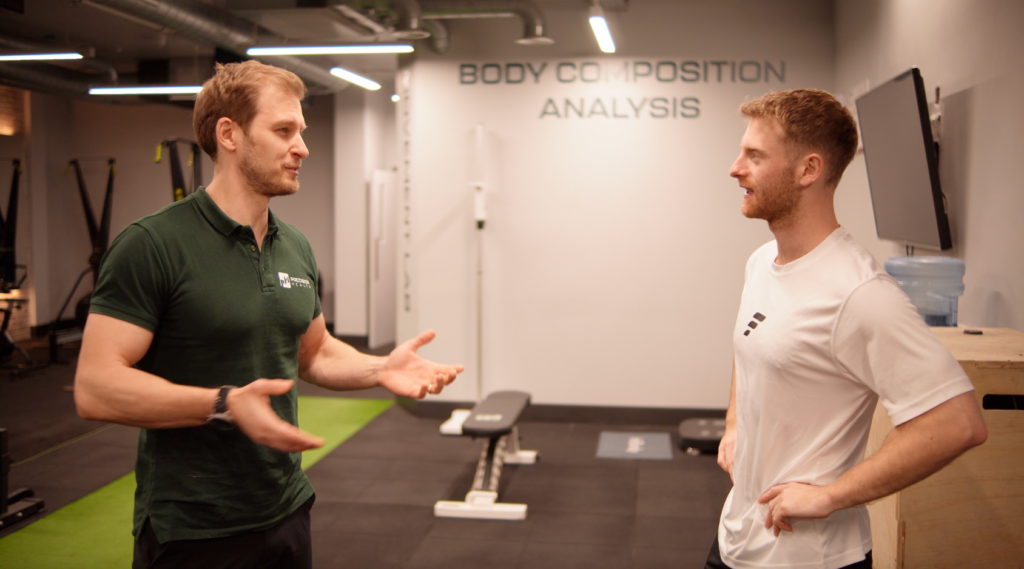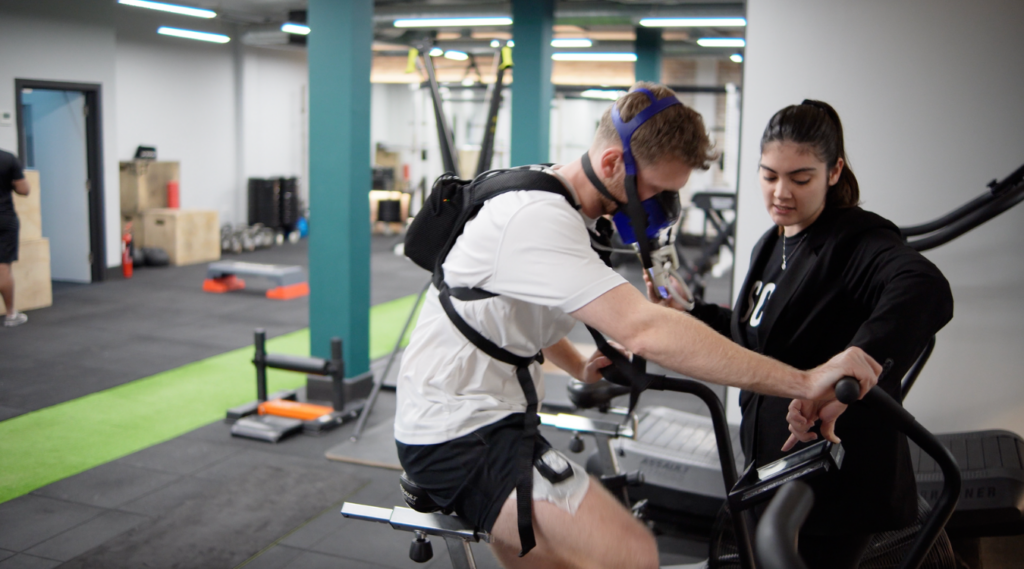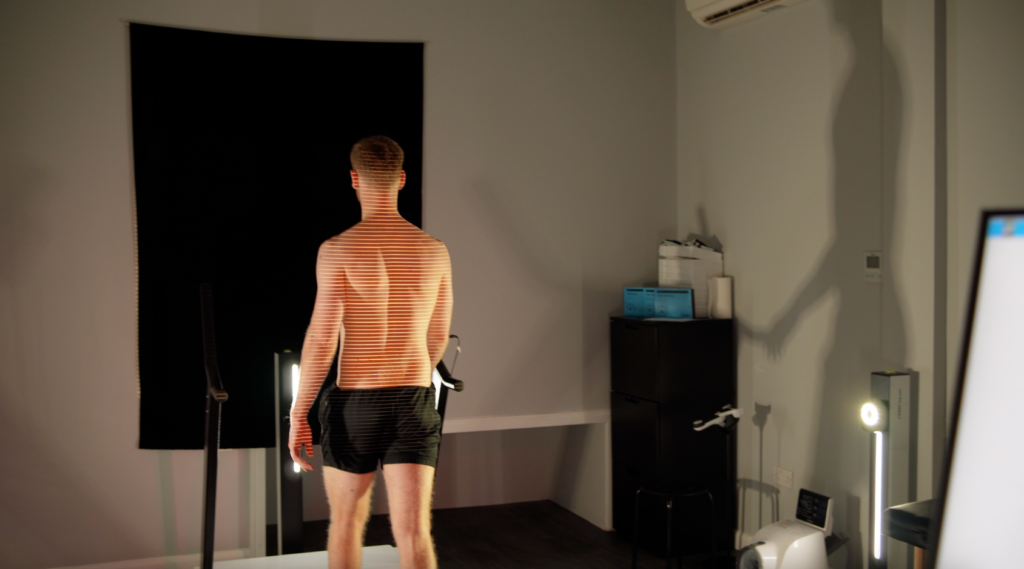

I’m Theo, part of the Business Development team at FFF. Due to the nature of my job, I train fairly frequently in a range of different styles and classes. Currently, my focus is on improving my CrossFit abilities (read about how that’s going here). However, one thing I have never had much of a handle on is where potential strengths and weaknesses lie from a scientific and physiological standpoint. I doubt I am alone in this. So I was excited to learn first-hand how a physiological assessment improves your fitness.
With a better understanding of our strengths and weaknesses, we can deploy techniques and strategies to help with our day-day training and get closer to our goals in a faster and more effective manner. Think of it like constructive criticism of your athletic abilities!
What is a physiological assessment?
A physiological assessment provides detailed standardised data on your current state of health and fitness.
There are a variety of tests you can undertake to give you a snapshot of your current health and fitness state, one of the most recognised tests is the VO2 max test which provides data on how much oxygen is used as you exercise and determines the maximal oxygen you can consume during exercise.
This test is particularly popular with endurance athletes such as long distance cyclists as improving VO2 max increases blood and oxygen delivery to muscles when the body is in a state of stress or fatigue.
The main benefit of undertaking a general assessment is to identify areas that are sub-optimal for both your physical performance and your health in the short and long term. By recognising weaknesses, you can make a plan of action as to how you can implement change to turn these areas of weaknesses into strengths.
Repeating certain tests over time also allows you to track your progress and see areas where you’re improving. Or, perhaps more usefully, see areas where you’re not seeing the progress you’d have liked and can adapt your training to make sure you do start moving in the direction you want to be.
My physiological assessment experience
The New Year presented the perfect time for me to learn a bit more about myself through a range of tests and assessments.
Precision Health is a new state of the art facility in Whitechapel, kitted out with an incredible gym and, most impressively, it is packed full of advanced testing technologies, which previously I had always assumed were only used by elite athletes.
However, at Precision Health they have recognised the value these tests can provide for enhanced performance and progression at all fitness levels.
I recently met with Co-Founder and Head Coach Virgis Silinskas, who took me through a full body assessment to provide me with further understanding of a variety of physiological factors and how I should be tailoring my training around these.
What does a full body assessment involve?
The full body health and fitness assessment I had at Precision Health covered four main areas of physiology:
- Metabolic Health – amount of energy (calories) used and what type of energy (carbohydrates/fats) is predominantly used during respiration.
- Biomechanics – posture and movement mechanics, really good for highlighting areas of weakness and things that could be holding me and my training back.
- Body Composition – measuring body fat and muscle mass, water balance and cell integrity.
- Biochemistry – analysing vitamin, mineral status, organ function and hormonal balance.
Each assessment is really valuable in itself, but when combining it together it provides a 360 view of your physiology and eliminates any guesswork when it comes to setting a perfect plan to reach your goals without compromising your health.
Testing & Results
1. Metabolic analysis
This consisted of two parts, part one being my resting metabolic rate which was done lying down with the breathing apparatus as well as a lung capacity test.
The second part was a bit more intense as it involved a “stress test” which was undertaken on an assault bike to determine VO2 max values and other metrics relating to performance and cardiovascular health.
The VO2 max test really pushed me as I started off at an easy target power output which lured me into a false sense of security, soon enough when the target increased, I was faced with a nasty combination of a heavy lactic acid build up in my legs and a battle with my lungs to keep oxygen coming in. Safe to say this was the hardest test across all of the assessments.


Results:
For my resting metabolic rate, there were clear in-balances in my breathing patterns. My Vo2 max score was above average when on the assault bike.
Recommended actions:
Based on the data, Virgis advised that the most efficient way to improve my overall metabolic health would be to focus on more zone 2 training (where my heart is sitting at around 140 bpm).
Another pointer would be to spend more time focusing on breath work – specifically the “box breathing” technique, which focuses on inhaling through the nose for 4 seconds, holding for 4 seconds, exhaling through the mouth and then pausing again for 4 seconds before the next breath. Not only will this help my respiratory patterns, but it is good for reducing stress too.
2. Biomechanics: Movement and Posture Assessment
This assessment consists of 3 parts.
First, I was tagged using tracer tags along certain points of my body so that the movement imaging equipment could accurately track and monitor my posture and movement patterns under the light in a dimmed environment.
- Part 1 was purely based on my static/standing posture.
- Part 2 involved me walking on a treadmill at a standard walking pace.
- Part 3 involved running at speed on the treadmill.
These three tests take into account spinal motion, pelvis, lower limbs and foot pressure measurements. This helps the team identify any problems and compensation patterns that might occur in my normal day-to-day movement as well as when my body is put under stress.


Results:
On both the first tests (static and walking) there were no real irregularities that were identified, however when running, there was one clear finding:
- When running at speed it was clear that due to a weakness and imbalance in my hips, I was overcompensating with my shoulders and arms to create extra momentum to drive me forward as opposed to using my hips, which adds extra unnecessary lateral and rotational movement in the spine.


Recommended actions:
I have been set exercises to improve strength in my hips. Most of these are focused on exercises such as planking and other mobility drills. Improving strength and removing any imbalance in my hips will not only help with running but help with progression in any other fundamental movements such as hip hinging and squatting.
3. Body Composition Analysis
This test was really short to complete using Inbody devices to accurately monitor body fat and muscle mass. This is a key test as it allows the team to test and retest how you are progressing over time in line with data and the plan/training you are following.


Results:
I was happy to hear that all of my metrics were considered above average for someone of my age. The data here is not necessarily important unless there are any stand-out warnings / red flags in the data. This test is more used as a measure that can be re-tested over time to measure progression.
4. Biochemistry
This is a test offered by Precision Health but was not one that I took on the day. however, through blood analysis, the team can look at your vitamin, mineral status, organ function and hormonal balance. This information is really useful to design a bespoke nutrition plan and advice on best-suited lifestyle changes to improve health.
What will I be implementing in my training in the next 12 weeks?
The real stand out for me has been realising the weakness in my hips and, as a result, how other parts of my body, such as shoulders and arms, have to move in-efficiently to compensate.
Over the next 12 weeks, Virgis has kindly set me up with a training programme via the PH Gym app, where I can log in and follow a range of exercises to add stability and strength to my hips before progressing with more complex exercises. I am going to make this a priority as it has been made clear that this will really help me progress with my training and movement in the long run.
I wanted to end this blog by saying a massive thank you to Virgis for taking me through all the tests and developing a personal training plan for the next 12 weeks. Virgis is an absolute expert in his field and truly passionate about what he does which translates to a really bespoke and tailored client experience.
If you would like to try out Precision Health Gym:
PH Gym are currently offering a free week of Semi-Private Personal Training plus a Posture and Body Composition Analysis (Worth £337). Simply email [email protected] with the subject line ‘I want the PH offer!’ to take advantage of this offer.